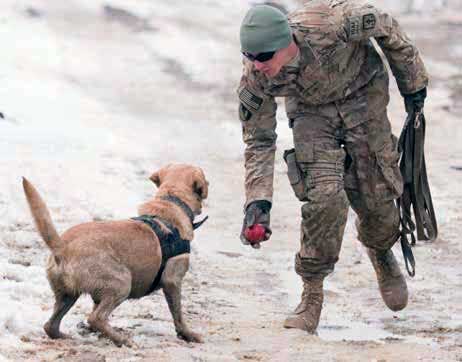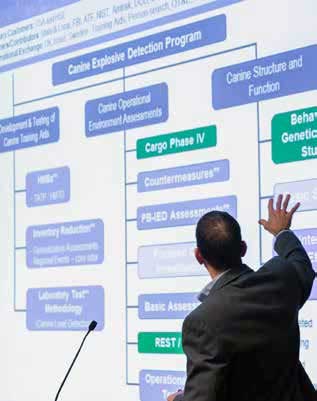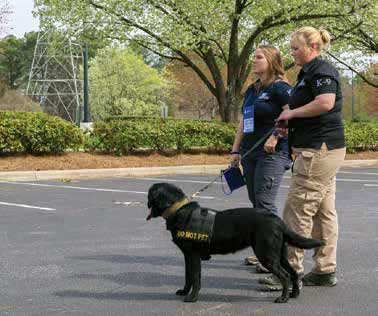Parent Category:

America is facing a shortage of K-9 sniffers to thwart domestic terrorists.
AKC may have the answer.
By Penny Leigh
In the world of working dogs, Labrador Retrievers rank high on the list of most employable. Their intelligence, biddability, and friendly natures make them excellent candidates for jobs ranging from guiding the blind to searching for lost children.
Their original purpose was retrieving game in the field, a task at which they still excel. Trainer and hunter Lane Kjellsen’s skill in honing his Labs’ natural instinct catapulted them into the winners circle at AKC Field Trials, designed to test retrievers’ hunting ability.
But recently, competitions have declined for Kjellsen as he turned his talents to a different hunt—one in which the result can mean life or death.
Focusing Labradors’ keen noses on the search for explosives is the goal at K2 Solutions, the detection-dog training center that Kjellsen founded in North Carolina.
His dogs can be spotted around the country, protecting sports stadiums, concert arenas, airport terminals, and more.
From Birds to Bombs
"Dogs work well in any type of social environment, are tractable to humans, and their mobility gives them an advantage over any other type of technical device," says Kjellsen, a former Army Special Operations Unit member who employs trainers and behaviorists from U.S. and British military backgrounds, as well as law enforcement and dog sports.
"Their innate hunting ability can be used to hunt explosives by substituting their natural prey with the explosives scent."
 U.S. Army Sgt. Garret Grenier, a dog handler, gives U.S. Army Staff Sgt. Drake, a mine detection dog, his favorite toy as a reward after a successful training session at Bagram Air Field, Afghanistan, Jan. 8, 2013. Drake and Grenier are members of the 49th Engineer Detachment (mine dogs). The dogs see the training and actual missions as games and are rewarded for a job well done with playtime
U.S. Army Sgt. Garret Grenier, a dog handler, gives U.S. Army Staff Sgt. Drake, a mine detection dog, his favorite toy as a reward after a successful training session at Bagram Air Field, Afghanistan, Jan. 8, 2013. Drake and Grenier are members of the 49th Engineer Detachment (mine dogs). The dogs see the training and actual missions as games and are rewarded for a job well done with playtime
And today, that ability to serve man by alerting them to bombs and firearms is more in demand than ever. As acts of homegrown terrorism and mass shootings become everyday news in the United States, government agencies, schools, malls, and theaters are seeking the services of detection dogs with one major problem: There are not enough dogs to serve the growing need.
Sporting Noses
The United States imports about 80 to 90 percent of their working dogs from Europe, which has a rich heritage for breeding and training dogs for police/military-style competitions and certifications.
German Shepherd Dogs and Belgian Malinois remain the most popular choice for patrol dogs by law enforcement, and many are dual-purpose canines who also perform detection work.
But the breeds in greater demand for public detection work are sporting dogs, including Labradors, German Shorthaired Pointers, and Vizslas. These breeds are less intimidating to the public, and their incredible hunting instinct is easily transferred to searching for explosives.
Calling AKC Breeders
Due to growing terrorism threats and consequent demand for working dogs within Europe and around the world, there is now a shortage of foreign dogs available to protect the United States.
"The irony is that as a nation we do not typically outsource the production of resources needed for national security. It is even more difficult to accept the fact that, as a nation, we cannot meet our own needs for working dogs when we have so many breeders and dogs within our borders," says Scott Thomas, former breeding program manager of the TSA Canine Breeding and Development Center.
The TSA’s Labrador Retriever detection-dog breeding program was eliminated in 2012 as part of budget cuts. This spurred Thomas to write the American Kennel Club and ask for support in encouraging a domestic breeding program that would reduce the need to rely on foreign sources for national protection.
AKC Board member Dr. Carmen Battaglia, a longtime German Shep- herd fancier, has been fascinated since he was a child with the contributions that his breed has made to the military. When he became president of the German Shepherd Dog Club of America in the early 1990s, he organized a trip by the club’s board to the Department of Defense canine center at Lackland Air Force Base, in San Antonio, Texas.
This began a long-term relationship between Battaglia and the military dog team, resulting in many trips to Lackland and Battaglia being named as an advisor to the TSA’s canine program. When Battaglia received the letter from Thomas regarding help with a U.S. breeding program, he took the matter to the AKC Board of Directors, which formed the AKC Detection Dog Feasibility Study Committee. Its goal is to document the current state of detection dogs use in the U.S. and explore how to increase the domestic supply of this crucial national resource.
Purpose-Bred Protectors
"AKC has always been a leader in purpose-bred purebred dogs. And these purpose-bred purebred dogs have the skills, ability, and breeding to produce the traits needed for detection dogs to successfully do their important jobs," Battaglia says. "It is a natural role for AKC to assist in meeting this national need to protect our country."


Driving It Home: Participants at the first AKC U.S. Detection Dog Conference explored the world of explosives-detection sniffers in detailed presentations (left) and through demonstrations by working K-9 teams
The AKC committee, headed by AKC Senior Vice President Mark Dunn, interviewed key stakeholders involved in bomb detection, including people from academia, government, military, policing, training, and breeding. Subsequently, the AKC has launched a number of initiatives focused on government relations, networking and education, and breeder outreach.
Government Relations
There are many obstacles that stand in the way of U.S. breeders being able to easily sell dogs to the government for detection work, including low-market price for top-working field-line puppies and complicated government vendor contracts that make it difficult for individual breeders.
The government has stated that European dogs are less expensive than buying U.S. dogs, but they do not include the additional expenses of travel that could last up to six weeks for their procurement team, including the related costs of a veterinarian; shipping the dogs; and conducting health screenings and training while they are in Europe and again when they arrive.
Also, most legislators are unaware of the United States’ dependence on foreign dogs and the fact that it is becoming increasingly difficult to meet U.S. needs from foreign sources.
The AKC Government Relations team, led by Vice President Sheila Goffe, has made strides in bringing these issues to the attention of law makers.
AKC Government Relations provided recommendations in the 2018 National Defense Authorization Act (H.R. 2810) to support using and developing additional sources for high-quality domestically bred working dogs. HR 2810 also requires the Department of Defense to provide reports on specific aspects of military working-dog evaluation, procurement, and breeding programs. This includes comparative costs of foreign versus domestically bred dogs, availability of domestically bred dogs, and non-classified requirements for "green" (minimally trained) dogs. HR 2810 has passed the House and as of this writing is under consideration in conference.
Goffe also was invited to testify on the issue before a Senate committee in October 2017, where she expressed the dire need for these dogs to protect the country.
"Experts recognize that there is no better or more efficient way to detect explosives than through the use of high-quality, specially trained scent detector dogs. Since the terrorist attacks on 9/11, and subsequent attacks worldwide, global demand for high- quality explosives-detection dogs has skyrocketed," Goffe says. "A shortage of appropriate, domestically bred dogs available for work as explosive- detection dogs presents a significant threat to U.S. security."
Networking/Education
The first AKC U.S. Detection Dog Conference took place in early 2017 to start a conversation about increasing the domestic supply of detection candidates. The stakeholders and speakers included members of government, academia, and private training and breeding facilities. A second conference is planned for late summer 2018.
In addition, the AKC committee members have conducted research to talk to the experts about the issue and needs, including visits to Lackland AFB, Auburn University Canine Performance Department, and the University of Pennsylvania Working Dog Center.
"There are not enough detection dogs to fill the growing need."
Breeder Outreach
The AKC works with thousands of breeders around the country, but most are unaware of the detection dog shortage.
The AKC Feasibility Study committee is taking steps to communicate the need to breeders through presentations to kennel clubs and parent clubs and articles in AKC newsletters and magazines.
Most training programs want to purchase dogs at about a year of age so they are ready to move into advanced training. But this can be difficult as not all breeders are willing or able to keep a puppy for several months so some training centers have started puppy programs so they can accept younger dogs.
The Right Stuff
The most successful detection dogs are developed from field and working lines known to produce dogs that can work all day without losing interest or energy.
"I look for drive, detection ability, tractability and intelligence," Kjellsen says. "The field-line dogs have been bred for a long time with a purpose to work. These are the type of dogs that can end up in rescue as their owners do not understand how to channel their energy into jobs."
In addition to Labradors, the preferred breeds for public detection work include the German Shorthaired Pointer, German Wirehaired Pointer, Vizsla, and such retriever breeds as Goldens and Flat Coats.
When the government receives a detection dog candidate, they must pass a stringent health examination, including hip, elbow, and lumbar radiographs, and then undergo an evaluation for these key traits:
- Sociability
Dogs must be sociable enough to be easily handled by people and to be at ease around people of all types, but should not be so sociable that they are distracted by human presence. - Environmental Stability
Dogs must not show fear or ner- vousness around loud and strange noises; they must show physical rigor whether working in very hot or cold temperatures; and they must be bold and willing to walk or climb on strange surfaces. - Desire to Obtain Reward
The dog’s drive to obtain a reward is the key to the dog working. Detection dogs are trained on toys, such as Kongs or tennis balls. The dogs must want that toy more than anything. Food is not used as a reward on the job as it is difficult for handlers to carry, and there is too much food in the environment that could confuse the dog. - Hunting Ability
The dogs must show intense drive to keep hunting, even when they are not finding anything, without getting frustrated and without giving false alerts.
Prevention Is Key
The role of detection dogs is not just about finding bombs, but also about preventing potential terrorists. Having detection dogs in public view is a major deterrent against crime.
There are efforts to build technical devices that recreate the ability of a dog’s scent glands, "but they are dependent on humans to direct them or physically move the suspicious substance to the device, whereas dogs proactively hunt and look for the substance," Kjellsen says.
In addition, machines are not always visible to terrorists, whereas dogs are working the crowds. Fortunately, K2 dogs have not had to stop a terrorist trying to commit a crime. But Kjellsen says he knows they are doing their job as they regularly detect similar scents, including firearms carried by undercover police.
"Dogs are the most effective method available to security personnel to expand the security perimeter, add mobility to the security force, cause detectable human behaviors, provide a deterrent, detect mobile explosives, and provide early warning," he says. "All these factors increase the likelihood that even if a determined terrorist attempted to attack an event, he or she would likely be forced either to initiate the assault prior to reaching the intended target or choose to abandon the plan."
AKC staff member Penny Leigh is theproject manager of the AKC DetectionDog Feasibility Study Committee.

